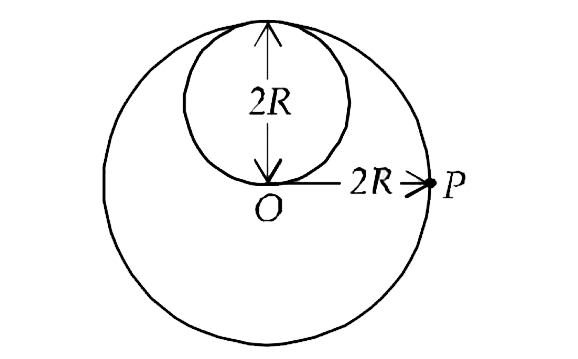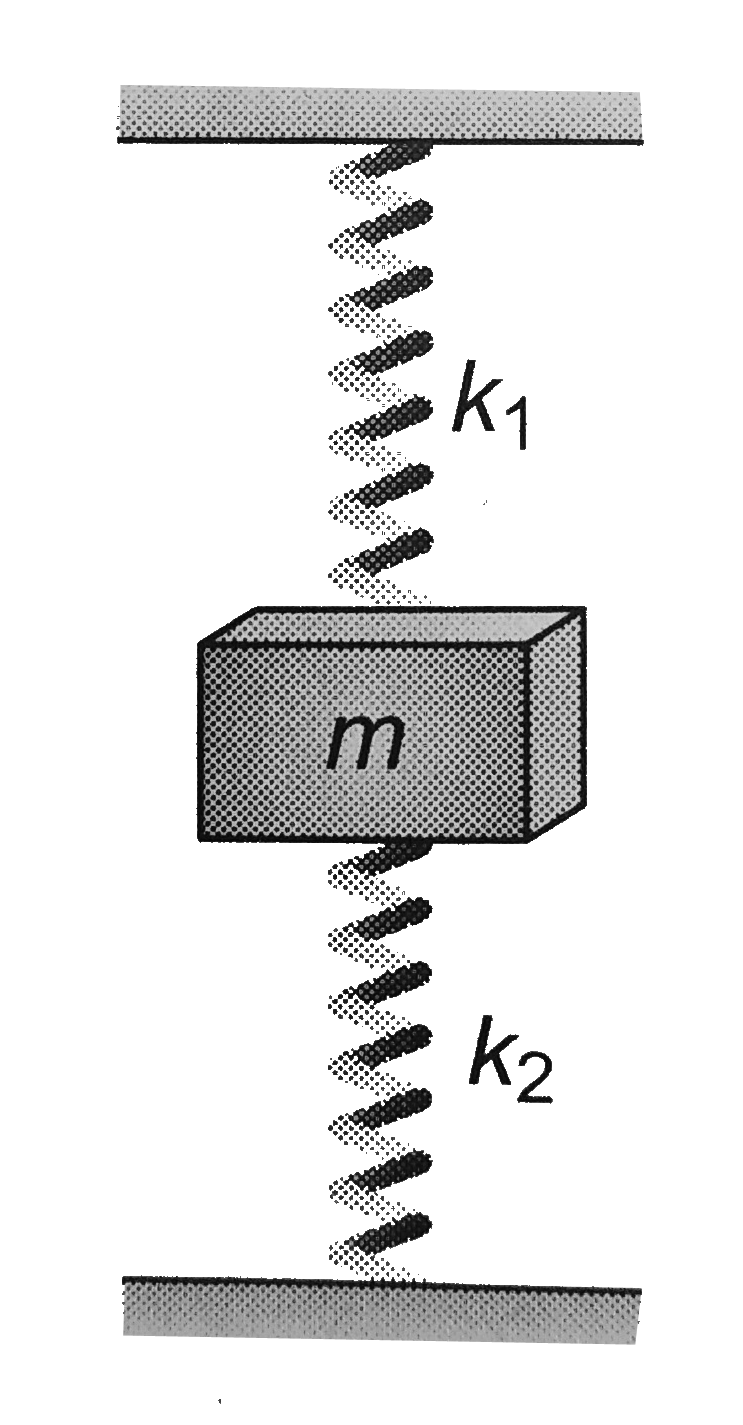
A source S emitting sound of 300 Hz is fixed of block A which is attached to free end of a spring SA as shown in the figure. The detector D fixed on block B attached to the free end of spring SB detects this sound.
The blocks A and B are simultaneously displaced towards each other through of 1.0 m and then left to vibrate. Find the maximum and minimum frequencies of sound detected by D if the vibrational frequency of each block is 2 Hz (velocity of sound is 340 m/s).
The motion of A and B is sychronized. Hence the maximum frequencies detected by D will be
fmax=(v+vDv−vS)f
(when S and D are approaching each other while at their equilibrium position.)
=(340+Aω340−Aω)f=(340+12.56340−12.56)×300=323Hz
Similarly, the apparent frequency will be minimum when the source and the detector recede from each other with maximum speed (=Aω)
fmin=(v−Aωv+Aω)f=(340−12.56340+12.56)×300=278.6Hz
Topper's Solved these Questions
- SOUND WAVES AND DOPPLER EFFECTBOOK - CENGAGE PHYSICS ENGLISHCHAPTER - SOUND WAVES AND DOPPLER EFFECTEXERCISE - Exercise 6.1
56 Videos
- SOUND WAVES AND DOPPLER EFFECTBOOK - CENGAGE PHYSICS ENGLISHCHAPTER - SOUND WAVES AND DOPPLER EFFECTEXERCISE - Exercise 6.2
72 Videos
- SOUND WAVES AND DOPPLER EFFECTBOOK - CENGAGE PHYSICS ENGLISHCHAPTER - SOUND WAVES AND DOPPLER EFFECTEXERCISE - Integer
16 Videos
- RIGID BODY DYNAMICS 2BOOK - CENGAGE PHYSICS ENGLISHCHAPTER - RIGID BODY DYNAMICS 2EXERCISE - Interger
2 Videos
- SUPERPOSITION AND STANDING WAVESBOOK - CENGAGE PHYSICS ENGLISHCHAPTER - SUPERPOSITION AND STANDING WAVESEXERCISE - Comprehension Type
5 Videos
Similar Questions
Do displacement particle velocity and pressure variation in a longitudinal wave vary with the same phase?
View SolutionA person riding on a merry go round emits a sound wave of a certain frequency Does a person at the centre observe the Doppler effect?
View SolutionThe average power transmitted across a cross section by two sound waves moving in the same direction are equal. The wavelength of two sound waves are in the ratio of 1:2, then find the ratio of their pressure amplitudes.
View SolutionA lamina is made by removing a small disc of diameter 2R from a bigger disc of uniform mass density and radius 2R, as shown in the figure. The moment of inertia of this lamina about axes passing though O and P is IOandIP respectively. Both these axes are perpendicular to the plane of the lamina. The ratio IPIO is

View SolutionA string of length L, fixed at its both ends is vibrating in its 1st overtone mode. Consider two elements of the string of the same small length at positions l1=0.2Landl2=0.45L from one end.
If K1andK2 are their respective maximum kinetic energies,then
View SolutionA block of mass 2.0 kg is moving on a frictionless horizontal surface with a velocity of 1.0 m/s figure towards abnother block of equal mass kept at rest. The spring constant of the spring fixed at one end is 100 The spring constant of the spring fixed at one end is 10 N/m. Find the maximum compression of the spring.
View SolutionA source S emitting sound of 300 Hz is fixed of block A which is attached to free end of a spring S_A as shown in the figure. The detector D fixed on block B attached to the free end of spring S_B detects this sound. The blocks A and B are simultaneously displaced towards each other through of 1.0 m and then left to vibrate. Find the maximum and minimum frequencies of sound detected by D if the vibrational frequency of each block is 2 Hz (velocity of sound is 340 m/s).
View SolutionIn the figure shown, a spring of spring constant K is fixed at on end and the other end is attached to the mass 'm' . The coefficient of friction between block and the inclined plane is mu . The block is released when the spring is in tis natural length. Assuming that the theta gt mu , the maximum speed of the block during the motion is.
View SolutionIn the figure shown a block of masss m is atteched at ends of two spring The other ends of the spring are fixed The mass m is released in the vertical plane when the spring are released The velocity of the block is maximum when

View SolutionOne end of a spring is rigidly fixed. A block attached to the free end of the spring is pulled through a distance x_(0) . On releasing the block, its amplitude of motion cannot exceed +-x_(0) . Why?
View SolutionA source S emitting sound of 300 Hz is fixed on block A which is attache to free end of a spring S_(A) as shown in figure. The detector D fixed on block B attached to free end of spring S_(B) detects this sound. The blocks A and B simultaneously displaced towards each other thrugh a distance of 2.0m and then left to vibrate. If the product of maximum and minimum freuquencies of sound detected by D is K + 10^(4) sec^(-2) . Find K . Given the vibrational frequencies of each block is 5//pi Hz . speed of sound in air = 300 m//s
View SolutionA mass m is attached to the free end of a massless spring of spring constant k with its other end fixed to a rigid support as shown in figure. Find out the time period of the mass, if it is displaced slightly by an amount x downward.
View SolutionA source S emitting sound of frequency 288 Hz is fixed on block B which is attached to the free end of a spring S_(2) and an observer O is on block A which is attached to the free end of spring S_(1) as shown in the figure. The blocks A and B are simultaneously displaced towards each other through a distance of 0.5 m and then left to oscillate. If the angular velocity of each blocks is 40"rad"s^(-1) , then the maximum frequency observed by the observer is (speed of sound in air is 340 ms^(-1) )
View SolutionA source S emitting sound of frequency 300Hz is fixed on block A which is attached to the free end of a spring SA as shown in figure. The detector D fixed on block B attached to free end of spring SB detects this sound. The blocks A and B are simultaneously displaced towards each other through a distance of 1.0m and then left to vibrate. The maximum and minimum frequencies of sound detected by D, if the vibrational frequency of each block is 2Hz are (Velocity of sound v=340m/s)

View SolutionA source 'S' emitting a sound of frequency 300 Hz is fixed on block ‘A’ while detector is fixed on block 'B' detects the sound. The block 'A' and 'B' are simultaneously displaced towards each other through a distance of 1 m and then left to vibrate. If the velocity of sound in air is 340ms^(-1) and S_A , S_B are identical the frequency of block A is 2Hz. Then
View SolutionA source .S. emitting sound of 300Hz is fixed on block .A. which is attached to free end on spring SA as shown in the figure. The detector .D. fixed on block .B. attached to the free end of spring SB detects this sound. The blocks .A. and "B. are simulataneously displaced towards eachother through a distance of lm and then left to vibrate. Find the maximum and minimum frequencies of sound detected by .D. if the vibrational frequency of each block is 2Hz (speed of sound 340ms−1)

View Solution

